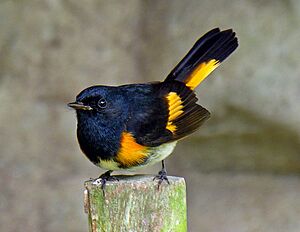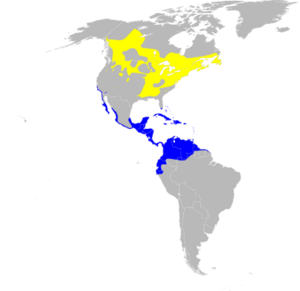American redstart facts for kids
Quick facts for kids American redstart |
|
|---|---|
 |
|
| Male in Chiquimula, Guatemala | |
 |
|
| Female | |
| Conservation status | |
| Scientific classification | |
| Genus: |
Setophaga
|
| Species: |
ruticilla
|
 |
|
| S. ruticilla range Breeding range Wintering range | |
| Synonyms | |
|
|
The American redstart (Setophaga ruticilla) is a small, colorful songbird. It belongs to a group of birds called New World warblers. These birds are found in the Americas. Even though it's called a "redstart," it's not related to the common redstart found in other parts of the world.
Contents
What's in a Name?
The American redstart got its scientific name from Carl Linnaeus in 1758. He was a famous scientist who named many plants and animals. The bird's genus name, Setophaga, comes from ancient Greek words. Sēs means "moth" and phágos means "eater." So, Setophaga means "moth-eater."
The species name, ruticilla, is a Latin word for "redstart." It comes from rutilus, meaning "red," and -cilla, a small ending. The word "redstart" itself means "red tail." This name fits the male bird well because of its bright red tail feathers.
How to Spot an American Redstart

The American redstart is a small bird, about 11 to 14 centimeters (4.3 to 5.5 inches) long. Its wings can spread from 16 to 23 centimeters (6.3 to 9.1 inches) wide. It has a fairly long tail, which makes it seem a bit longer than it is. These birds are also very light. Males weigh about 8.6 grams (0.3 ounces) in summer. Females are similar, weighing about 8.7 grams (0.3 ounces). They lose some weight in winter.
Breeding males are easy to spot. They are mostly shiny black with bright orange-red patches. These patches are on their wings, tail, and sides of their chest. The rest of their belly is white. Females and young birds look different. They have green on their upper parts and yellow patches instead of orange-red. Their tails are black in the middle.
The bright colors come from special pigments called carotenoids. Males have red and yellow carotenoids, which mix to make orange. Females only have yellow carotenoids. This means males look brighter and more colorful.
Their song sounds like a series of musical "see" notes. Their call is a soft "chip."
Rare Hybrid Birds
Sometimes, an American redstart might breed with another type of warbler. This creates a rare "hybrid" bird. Scientists have found two such hybrids between American redstarts and magnolia warblers. One was in Ohio, USA, and the other in Quebec, Canada. In both cases, the mother was a magnolia warbler and the father was an American redstart.
Where They Live and Travel
American redstarts are common birds, especially compared to other warblers. They breed in North America, across southern Canada and the eastern United States. When winter comes, they fly south. They spend the colder months in Central America, the West Indies, and northern South America. They are very good at migrating long distances.
During the breeding season, redstarts like to live in forests with open spaces. They prefer forests with many deciduous trees, which are trees that lose their leaves in the fall. They also live in areas where new forests are growing.
When they migrate, they can be found in many different places, including bushy areas. In winter, they live in almost any woody habitat. They often like shade-grown coffee farms. These farms grow coffee under native trees and shrubs, which gives the birds more places to live. Redstarts can be found at different heights, from sea level up to 3,000 meters (9,800 feet) in South America.
How They Behave
Breeding and Family Life
American redstarts build their nests in open woodlands or bushy areas, often near water. They make a neat, cup-shaped nest low in a bush. Females lay 2 to 5 eggs. The mother bird sits on the eggs for 10 to 13 days to keep them warm. The baby birds leave the nest after about 9 days. They might stay with one parent for up to three more weeks.
Young male redstarts can have babies in their first year. However, they still look like females, which means they might not be as successful. Most young females, though, successfully have babies in their first year.
Most American redstarts have one mate. But about 25% of males have more than one territory and more than one mate. Even when a pair is together, up to 40% of the babies might have a different father. The brighter the male's colors, the better he is at keeping his territory in winter. Brighter males are also more likely to have more than one mate. Males are very protective of their areas. The strongest males get the best habitats, like wet mangrove forests.
What They Eat
Redstarts mostly eat insects. They are very active birds. They often catch insects by flying out from a branch to grab them in mid-air. They also pick insects off leaves. You might see them fanning their tails open and closed. They do this to scare insects out of the bushes so they can catch them!
Their diet includes many different insects. They eat caterpillars, moths, flies, leafhoppers, small wasps, beetles, aphids, and spiders. They sometimes eat a few berries and seeds, like those from barberry or magnolia plants.
Dangers and Lifespan
The oldest known American redstart lived for over 10 years. Other adults have lived to about 5 years old. However, many young birds do not survive their first year. They face dangers from predators on the ground and in the air.
Predators are most common during the breeding season. This is when eggs and helpless baby birds are easy to find. Female birds often get caught by predators while sitting on their nests. Ground predators include red squirrels, fishers, eastern chipmunks, American black bears, flying squirrels, fox snakes, and domestic cats. Birds that hunt from the air include blue jays, common ravens, northern saw-whet owls, and different types of hawks.
Protecting the Redstart
To help American redstarts, we need to protect their homes. This means saving habitats where they breed and where they spend the winter. Redstarts and other "coffee birds" help coffee farms by eating insects. This has encouraged farmers to grow coffee under shade trees. These trees provide extra homes for the birds.
While shade tree coffee farms are a good idea, we still need more natural habitats. The best way to help American redstarts is to protect their natural forests and other homes.


